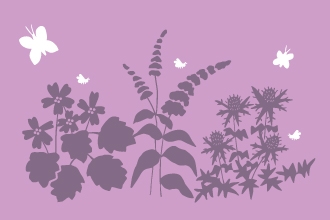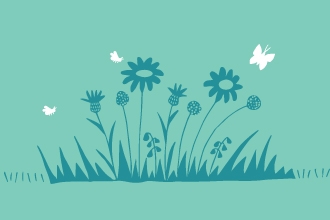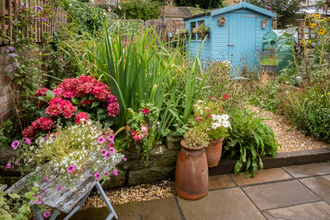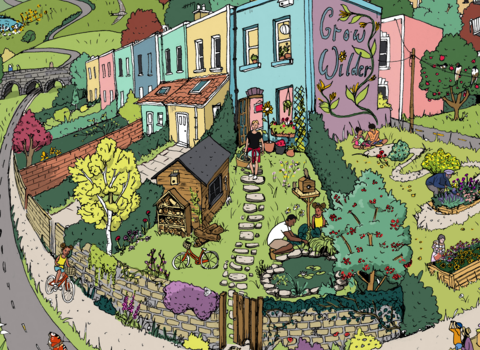
Hannah Bunn
Individual garden: Vida Green
Name: Vida Green
Category: Individual garden in the wildlife gardening competition 2023
Area: Staple Hill, Bristol, BS16
What makes your garden wildlife friendly?
Vida: We've been trying to create a variety of natural habitats on a small scale, depending on what type of soil the different bits of the garden have. E.g. in one area we've got sandy, poor quality soil so we've turned that area into a wildflower meadow. We've placed various ramps and stone piles to help smaller creatures navigate the wild space and escape if they get stuck. We've left rotting wood piles in a few places so that native beetles can thrive. We've used different materials (logs, wood, stone and bricks) to create borders for our garden beds, creating lots of nooks and crannies for insects to hide. We've put bird boxes and feeders in some places, changing what we offer them depending on the season. We don't mow the grass and we only remove cuttings from plants when necessary. We have been incorporating as many plants as possible that are native to the UK and local area by buying lots of plants from places such as Grow Wilder which have nature's interest at heart.
We have added native trees into the garden (a plum tree, an apple tree and a dwarf crabapple tree) for the local birds. We've tried to add interest to the different areas by adding plants at different growing heights (e.g. climbers as well as scramblers and ground cover varieties). We let most of our plants go to seed so they can self-pollinate and let the garden grow organically. We've dug a pond and created a bog garden to add a water element to the space. Since adding this to the garden, we've been noticing more and more wildlife.
Tell us what you love about your garden
Back in 2020 when my partner and I first moved into our home, the garden was just a long patch of lawn with some non-native flowers on the borders. We wanted to bring more wildlife into the garden so we have spent the past few years digging up the lawn and adding in as many native and pollinator-friendly plants as we could. We love how colourful our garden has become and the amazing noises we now hear when we're outside in the garden. It smells incredible since we've planted various types of fragrant flowers. We wanted our garden to be a nature wonderland and a haven for animals. We've designed the garden so that there is something different around every corner. We love sitting outside and listening to the sounds of nature - from the animals flying through for a quick visit, to the babbling of the wildlife pond.
Stephanie Chadwick
What wildlife have you seen in your garden?
Different species of bee (bumble bee, carder bee, honey bees), butterflies and caterpillars, dragonflies, moths, newts, tadpoles, foxes, birds (blue tits, robins, sparrows, goldfinches, wood pidgeons, crows, magpies), slugs and snails (to the detriment of some of our plants!), beetles, spittlebugs, aphids, ladybirds, waterboat men, hoverflies, shield bugs, squirrels, lots of spiders!
Vida was a finalist!

Stephanie Chadwick
It's meant to be messy! Wildlife doesn't care about straight lines. Do the pond sooner rather than later because it brings so much more wildlife. Don't get carried away and try to fill every space with young plants. The plants will fill the space. Just be patient and let the garden grow at its own pace.
Feeling inspired?
Vida has used all of her senses to appreciate the garden fully. Sitting and noticing the wildlife is a wonderful thing to do for mental health, seeing the beauty of what's there and maintaining the garden as well. Gorgeous. Here are a few ideas that you can try in your garden or community outdoor spaces as inspired by Vida and also extra advice from the Team Wilder Community Ecologist.
Mini meadow It was really nice to see the pond next to the longer grass as this can provide shelter for the amphibians and invertebrates. You might want to plug plant or sow seed into some parts of the grass (e.g. either side of the path) to increase the diversity of species and benefit pollinators. It seems like the area receives a lot of sun and therefore you could plant species such as oxeye daisy, common knapweed, purple selfheal, common toadflax, bird’s-foot trefoil and field scabious. For more shaded locations you might want to plant red campion, yarrow, garlic mustard and wild carrot. The grass around the edge of the mini meadow (e.g. near the boundaries and pond) could be left to grow long over winter rather than cut at the end of the flowering season. The creation of these different microclimates can really help pollinators, such as butterflies, as it create warm pockets for them to rest and warm up.
The mini meadow can be sown with wildflower seeds and/or planted with plug plants in the spring or autumn (September-November). Ensure that the grass is mown very short within the area before you want to sow the seed. Collect the arisings immediately so that the nutrients don’t leach back into the soil (wildflowers grow well in low nutrient soils). Then, if sowing seed, create at least 50% bare ground by raking or using a hand scarifier. I have provided additional resources below to help.
Wildflower meadow creation
Plantlife meadow creation advice
Magnificent Meadows

Stephanie Chadwick
Vertical space Climbing plants can be added to the vertical space, such as walls and fences, to enhance the value for wildlife. Species such as ivy, honey suckle, climbing rise, hops, passion flower and jasmine could be grown. Honey suckle is a night-scented plant so would also attract moths which would then benefit bats.
Attract bats and moths
Ponds are amazing for wildlife, see real ponds and advice on the link below.
Team Wilder ponds
Hibernacula - Wiltshire Wildlife Trust have advice on how to build hibernacula for amphibians and reptiles that can be located nearby ponds.
Resources

West of England Combined Authority and Natural History Consortium
Be part of Team Wilder
Feeling inspired by this wildlife garden? Try something for yourself at home, in your community, school, business or land, no matter the size.
All actions for nature collectively add up and makes a difference for people and wildlife.
Share your actions for nature, like Vida, and motivate others to do the same.
Log your actions for nature on the map
















